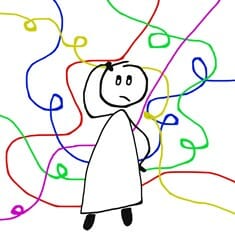Are you trying to manage chronic pain and bipolar disorder? Did you know that bipolar disorder and chronic pain have been linked? Not just the emotional anguish you often feel, but actual physical pain.
It’s not only the muscle aches and lethargy that often comes with depression but the pain that is recurring or never seeming to really go away.
1
Does Bipolar Cause Physical Pain?
Physicians, psychiatrists and other health professionals are still divided but a majority are leaning towards the fact that your illness could be causing your chronic pain.
Research has shown that the physical pain you feel could be one more symptom of bipolar depression or caused by it.
The studies show that not only do you have to deal with the emotional aspect of bipolar depression but possibly the physical ones as well. Some of the ones you might be familiar with include:
- Chest pain
- Muscle aches and cramps
- Gastrointestinal problems
These are the common ones that everyone can experience but seem to occur consistently with bipolar patients.
3 (bipolar patients have a higher prevalence of multi-site pain than non-bipolar patients)
It is thought that depression and chronic pain “feed” off each other.. When you’re in pain depression can set in, and your depression can manifest as pain. Unfortunately, people with bipolar are often diagnosed with 3 other types of physical pain.

- Migraines
This type of severe headache is generally concentrated on one side of your head. Nausea, vomiting, and dizziness are common, along with vision problems and an acute sensitivity to light and sound. It is estimated that 16 percent of the population suffer from these debilitating headaches.
Sometimes there are a few warning signs before a migraine hits and identifying these can also help you manage depression if it often coincides with the headache.
- Stiffness in the neck
- Constipation
- Congestion without accompanying flu or allergy symptoms
- Mood changes that can include depression or euphoria
While 16 percent or so of the general population suffer from migraines, it is thought that these headaches occur in 25 percent of bipolar patients. Rapid cycling is a common factor, and many have also been diagnosed with bipolar ll.
4 (bipolar patients with migraines are 88% more likely to have rapid cycling)
- Fibromyalgia
The main symptom of fibromyalgia is almost continuous musculoskeletal pain. It is thought that around fifteen percent of people diagnosed with bipolar also have or develop this condition.
5 (bipolar prevalence in fibromyalgia patients)
It is classified by “dull” aches in the muscles throughout the body, and it can be confused with the same feelings of pain that are often symptomatic of bipolar depression. This can make it difficult to initially diagnose.
Treating the overactive neurotransmitters, which is thought to be the cause of fibromyalgia is difficult when you’re also on medication for bipolar disorder. This is because the SSRIs (serotonin reuptake inhibitors) often prescribed to calm neurotransmitters have been known to induce mania.
- Arthritis
This may be surprising, but rheumatoid and osteoarthritis has been linked to bipolar 1 and 2.
Both types of arthritis are classified by swelling and stiffness in the joints that is severe. Bone spurs and loss is also a common indicator.
14 percent of people 25 or older have been diagnosed with osteoarthritis but it is more common in adults over 65. Rheumatoid arthritis (RA) affects not only the joints, but also the eyes, nerves, heart, lungs, kidneys, and bone marrow. This autoimmune disease afflicts an estimated 1 percent of the world’s population, and its effects can be devastating on the suffer.
Recent studies indicate that bipolar is twice as likely to occur in someone with RA.
6 Similar research also found that it was more often found in Bipolar 2 patients than those with Bipolar 1. An additional study noted that people with osteoarthritis were almost 3 times as likely to also have a type of bipolar disorder.
Even without bipolar disorder, chronic pain is tough to handle. Often adding to the problem is trying to convince your physician and/or psychiatrist that your pain is real and not “imagined”. When you have bipolar it can even exacerbate your symptoms.
This doesn’t mean that you have to be resigned to suffering. There are a few treatment options.

Can Chronic Pain Be Treated?
“Depression adds a double whammy to chronic pain by reducing the ability to cope,” says Beverly E. Thorn, a professor of psychology currently at the University of Alabama. She also wrote the book, Cognitive Therapy for Chronic Pain.
With the wide array of prescription drugs, you would think that treating chronic pain would be easy. This is not always the case when you have a type of bipolar disorder. Some medications can and do interact with the ones you are already taking for the mood disorder, and others can seem to have little or no effect on your pain.
Finding the right combination won’t be easy, expect complications of some sort along the way. However, never hesitate to call a medical professional if you think there is a problem with any of your medications.
If you’re worried about drug interactions or just want to manage the pain without adding more pills to your daily routine here are a few tips that could help.
- Manage Stress
This is often easier said than done, regardless of your mental health, but there are ways you can limit it.
7 (group psychotherapy and stress management aid in bipolar control) Coping skills, keeping a journal and certain breathing techniques can all help you mitigate stress.
Also, when possible always remove yourself from a tense or stressful situation. Your psychiatrist, therapist or bipolar support group can also help you learn the techniques you need to keep stress at a minimum.
- Communication
Not communicating the problem to your mental health advisor will not make the chronic pain go away. If you aren’t willing to discuss your issues, there is almost no chance that things will improve.
Be open and honest, no matter how “cliché” that sounds. It is usually the only way you can safely relieve the pain and still stick with your bipolar treatment plan.
- Have an integrative approach
Instead of only relying on your mental health care provider, include your physician as well. Both will have a different approach to treatment, and this might be exactly what you need.
8 (integrative therapy is helpful in bipolar substance abuse)
Just make sure that everyone you see knows what you are taking, including the dosage and how often. The last thing you want is a bad drug interaction combined with the symptoms of bipolar.
- Exercise
You don’t have to go out and train for a marathon but daily exercise can help reduce some types of chronic physical pain. Certain “feel good” chemicals are released in the brain when you are physically active, and this can also help combat depression.
While these are only tips, they could help you at least alleviate some of your chronic pain.
Obviously, there are also OTC drugs and prescriptions that can help reduce or temporarily eliminate your pain.
For some people, antidepressants help and have even eliminated the chronic pain; but don’t go running off thinking that this is the right option if you haven’t talked to your primary mental health care provider.
Since depression and chronic pain have been linked, there is research showing that Tricyclic antidepressants can be effective at relieving migraines and pinched nerves. These older medications have shown to be effective at minimizing neuropathic pain that could be exacerbated by depression, but they also have a noted risk of causing a manic or hypomanic episode.
If you are interested in this type of medication one to consider is Carbamazepine, an anticonvulsant that is chemically related to tricyclic antidepressants. It is one of the only mood stabilizers listed on the American Psychiatric Association’s guideline that has shown to be effective at treating chronic pain.
With an estimated 50% of bipolar patients also experiencing recurrent pain, this medication can be helpful.
9 (carbamazepine treats neuropathic pain and bipolar)
There are side effects associated with this drug and it can interact with other types of medication, so be sure that you have full disclosure with your prescribing physician.
2
More information on carbamazepine can be found at www.ncbi.nlm.nih.gov/pmc/articles/PMC4321019/.

Other prescribed medications that can help are:
a. Effexor and Cymbalta. These are classified as antidepressants and have shown effectiveness at relieving chronic pain. However, they could interact with your other medications and/or cause mood changes.
b. Anticonvulsants are not normally used to manage bipolar disorder but a few like Gabapentin have helped stabilize moods and reduce some types of chronic pain – neuropathic pain, in particular. Research is still ongoing to see if anticonvulsants can also contribute to mania, and results are pending.
Lyrica has been approved by the FDA for pain treatment, but like other anticonvulsants not for bipolar disorder.
c. Lidopen or topical lidocaine is an antidysrhythmic that is prescribed for irregular heartbeats. While its possible interactions with common bipolar meds is not yet known, its expense and the fact that it only treats localized pain makes it a little prescribed medication for most types of chronic pain.
d. Opioid analgesics are coming under fire, for a good reason. Addiction is common and this can be dangerous if you are bipolar.
10 (bipolar patients are over 2 times more likely to be prescribed opiates for pain)
This is especially true if you have a history of addiction or even if it runs in the family.
If you are prescribed any type of oxycodone, tramadol, or morphine for your chronic pain, it is important that you stay in close contact with your prescribing health care provider. The last thing you want is to add another problem.
Some other medications that can minimize pain and do not require a prescription include.
- Acetaminophen (Tylenol)
- NSAIDs (aspirin, naproxen and ibuprofen)
Both of these can provide temporary relief from muscle stiffness and aches. In addition, NSAIDs can be effective at reducing inflammation due to joint swelling and irritation.
Unfortunately for many, the relief they provide is often limited and minimal. While there is little evidence to support or disprove that NSAIDs interact with most common medications prescribed for bipolar disorder it is a possibility and should be discussed with your physician or psychiatrist before you use them to treat chronic pain. Furthermore, NSAIDs can cause stomach ulcers.
You might also be able to find some relief from topical pain relievers. Creams and ointments do have less of a risk of interacting with your existing medications but they might not be as effective as you hoped for.
Just remember to discuss any type of pain medication with your primary care provider before you add anything new to your daily regime.

What About Drug Interactions?
Tips to Prevent Drug Interactions
Drug interactions aren’t rare, and this is something you need to be aware of. It’s easy to happen and the effects can be devastating both physically and emotionally.
Side effects can be as minor as occasional dizziness and upset stomach or as major as a manic episode, along with everything in between.
There are 3 simple things you can do to prevent an accidental drug interaction.
- Tell your doctor, therapist, pharmacist and every other health professional you see exactly what you are already taking, before you accept a new prescription. Even though your medical chart should have a complete list of your existing medications, it’s always a good idea to be sure.
- If it is possible bring your prescription bottles with you to your doctor visits, especially if this is your first appointment with them. This helps to ensure that nothing is overlooked.
- Disclose any nutritional or herbal supplements and over-the-counter medications that you are taking. Some can interact with pain and mood stabilizers.
One example of a common drug interaction bipolar patients need to be aware of is lithium toxicity, which can be caused by the use of ibuprofen and other anti-inflammatory medications. Signs can include tremors and shaking, especially in the hands, and can cause permanent damage.
11 (irreversible damage from lithium toxicity)
If you believe that this might be occurring, contact your physician or mental health care provider immediately.
You can find more information on possible drug interactions at; www.mdedge.com/psychiatry/article/100879/bipolar-disorder/avoiding-common-drugdrug-interactions
When No One Believes You
Have you ever been told that your chronic pain is “all in your head?” If so, you aren’t the only one. While bipolar depression can cause various aches and pains that often come with or intensify your feelings of lethargy, this certainly doesn’t apply to everything.
If your physician or psychiatrist won’t listen to you, don’t give up. Keep a journal detailing all the pain you feel and when it occurs.
Demand additional tests and if necessary, seek treatment from another licensed professional health care provider. Just remember to inform everyone on your treatment team what medications you are taking, along with the dosage and frequency.
 Medically reviewed by
Medically reviewed by